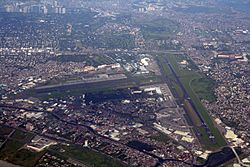Manila International Airport facts for kids
Quick facts for kids
Manila International Airport
Ninoy Aquino International Airport
|
|||||||||||||||
|---|---|---|---|---|---|---|---|---|---|---|---|---|---|---|---|
 |
|||||||||||||||
| Summary | |||||||||||||||
| Airport type | Public | ||||||||||||||
| Operator | Manila International Airport Authority | ||||||||||||||
| Serves | Manila | ||||||||||||||
| Location | Parañaque and Pasay, Metro Manila | ||||||||||||||
| Elevation AMSL | 23 m / 75 ft | ||||||||||||||
| Coordinates | 14°30′31″N 121°01′10″E / 14.50861°N 121.01944°E | ||||||||||||||
| Website | www.miaa.gov.ph | ||||||||||||||
| Runway | |||||||||||||||
|
|||||||||||||||
| Statistics (2007) | |||||||||||||||
|
|||||||||||||||
|
Statistics from the Air Transportation Office.
|
|||||||||||||||
Ninoy Aquino International Airport (NAIA), also known as Manila International Airport (MIA), is the main airport serving Manila and the surrounding Metro Manila area in the Philippines. It's a very busy place where people fly to and from many different countries.
The airport is located about 7 kilometers (4.3 miles) south of Manila. It sits right on the border between the cities of Pasay and Parañaque. This airport is super important for travel and trade in the Philippines.
Contents
Airport Terminals
NAIA has four main buildings called terminals. Each terminal helps handle different types of flights.
- Terminal 1: This terminal is mostly used for international flights. This means planes arriving from or leaving for other countries.
- Terminal 2: This terminal handles both international and domestic flights. Domestic flights are those that stay within the Philippines.
- Terminal 3: Like Terminal 2, this terminal also serves both domestic and international flights. It is one of the newer and larger terminals.
- Terminal 4: This terminal is mainly for domestic flights, helping people travel to different parts of the Philippines.
Airport Operations
The airport is managed by the Manila International Airport Authority. It has two main runways where planes take off and land. These runways are made of concrete and are very long to support large aircraft.
In 2007, the airport was very busy. Over 20 million passengers traveled through NAIA that year! This shows how important it is for connecting people and goods around the world and within the Philippines.
Getting to the Airport
There are several ways to get to Ninoy Aquino International Airport.
Roads and Expressways
The airport is connected by major roads and expressways. The NAIA Expressway is a special highway built to make it easier and faster to reach the airport. This helps reduce traffic and makes travel smoother for passengers.
Public Transport
You can also reach the airport using public transportation. There is a railway station nearby called the Nichols railway station. From there, you can connect to other parts of the city.
Images for kids
-
The airport's control tower in front of Terminal 2.
-
An Airbus A380 parked on its test flight in 2007.
See also
 In Spanish: Aeropuerto Internacional Ninoy Aquino para niños
In Spanish: Aeropuerto Internacional Ninoy Aquino para niños










